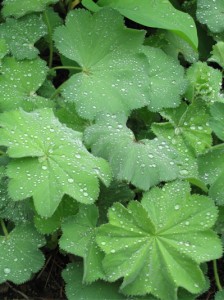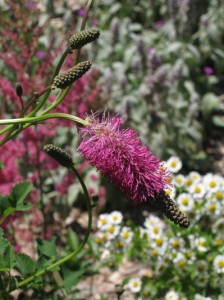Lessons from a Tough Year
January 3, 2010 by admin
Filed under Garden Design, Perennials
2009 was the worst growing season in about a decade. Here in the Northeast, it started out as “the year without a summer” and then became “the year with the summer we wish hadn’t come after all.” After a long, ultra cool and rainy spell it became stiflingly hot and humid practically overnight. Only in September did it become tolerable, but it remained erratic.
While I don’t want to see another year like 2009 any time soon, difficult weather years provide good opportunities to learn valuable gardening lessons. Weather, of course, has a big influence on garden beauty (or ugliness) mostly because of its impact on plant health. When plants struggle, gardens don’t look good. 2009 was a year in which lots of plants struggled.

In 2009, lady's mantle withstood weather that devastated many other plants.
Mostly it was a matter of disease. If it was fungal, we had it here in the Northeast: powdery mildew, late blight (along with every other kind of blight), rust, rust and more rust, and rots I couldn’t begin to identify. At one point I heard informally that commercial plant growers were spraying fungicide at unheard-of rates. It wasn’t hard to believe. I, too, sprayed things I’ve never sprayed before in hopes of nipping diseases in the bud, but many normally reliable performers succumbed. The undersides of Hydrangea arborescens leaves became a mass of orange pustules before dropping off prematurely. Snapdragons bloomed half-heartedly and then rotted at the base. Even hostas, normally great performers, were a total loss—not because of disease, but because 2009 was also a record-breaking slug year!
So, what was still looking good at the end of that horrendous season? In the shade department, Hellebore, Epimedium, Siberian bugloss (Brunnera), Geranium macrorrhizum, Rodgersia, white wood aster (Aster divaricata), Heuchera villosa ‘Autumn Bride’, wild ginger (Asarum), ferns and (in light shade) astilbes and lady’s mantle (Alchemilla) were some of the best performers among perennials. That’s what I’d expect. These plants always look good. Any shade garden designed for long-term low maintenance and long-season interest in the Northeast (as long as it’s not a native plant garden) should be made up primarily of plants like these.
Among sun-loving perennials, many North American natives really showed their strength. Bluestar (Amsonia tabernaemontana), turtlehead (Chelone), tickseed (Coreopsis), purple coneflower (Echinacea purpurea), Helenium, Rudbeckia fulgida and Culver’s root (Veronicastrum virginicum) all sailed through summer. Phlox maculata ‘Rosalinde’ proved once again why it’s superior to every other phlox out there.

Burnet (Sanguisorba) looks delicate, but it came through 2009 with flying colors.
Among the non-natives, catmints (Nepeta), daylilies (Hemerocallis) and betonies (Stachys) of all kinds seemed no worse for wear, as did some lesser-known perennials such as burnet (Sanguisorba). Grasses showed a lot of resilience, although some didn’t attain their normal size because of the extended cool spring (most ornamental grasses need sun and heat to develop). The story is the same here as for shade plants: the ones that looked good at the end of 2009 were the ones that always look good.
So what’s the lesson here? To fill your garden with plants that are naturally disease resistant. They are the only ones capable of looking good whatever the weather delivers, and 2009 was the proof of that pudding. It’s fine to have some plants you just like a lot, even if you know they’re temperamental, but a garden full of them will eventually disappoint.
This winter, if you’re thinking about making additions to your garden in 2010, my advice is to pay careful attention to the invisible qualities of plants, like disease resistance. They’re the equivalent of a great personality in a human being—they may not be what you notice first, but they’re what you’ll grow to appreciate in the long haul. And with that thought in mind, here’s to some easier gardening years in the coming decade!

